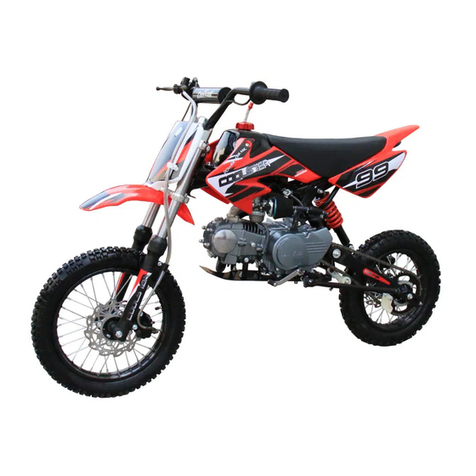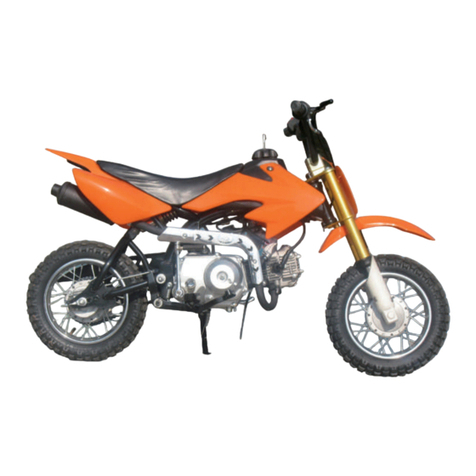PERIODIC MAINTENANCE
Periodic maintenance is the best way to help the machine perform well, give
longevity and provide safety and low cost operation. In addition, you will be
spared from many-worries from self caused problems, resulting from poor
maintinence or no maintinence. A - Before every ride:
1.Check the Cables and efficiency of brakes.
2.Check the lubrication and chain tension settings. The chain free play should
be (5 mm) (.200in) After every ride clean the pocket bike carefully and
keep it
clean. Do not use aggressive cleaning detergents.
3.After 1-hour of use, wash the air filter In air drying spirits and lubricate it
with special oil for air filters.
4.After 1- hour of use, check the state of the clutch pads. Review the clutch
adjustment.
B. After every 5 hours of riding:
5.Check the tightness of all bolts and nuts. Tighten carefully to prevent
damage to other parts.
6.Wash the air filter in gas and lubricate it with special oil for an air filters to
better catch the dust.
7.Clean carefully the carburetor float chamber.
8.Check the brake pads, the thickness of brake lining cannot be less than 1
mm (.039 in). Review the basic brake adjustment
9. Check the state of the clutch pads. - the thickness cannot be less than 1
mm (.039in). Review the clutch adjustment.
C. Every time after 10 hours of riding;
10. Check the state of the clutch pads - the thickness cannot be less than 1 mm
(.039in). CHAIN SETTING AND MAINTENANCE
To set the chain tension, loosen the Nut (920.011.01) of the axel thru the rear
wheel and the nut (914.021.01) of the rear Caliper anchor plate. The required
chain tension (chain free play ) is (5 mm) (.200in) and is performed by equal
movement of the Axel adjustor plate (920.009.01) on the both sides of the rear
wheel. When the adjustment is correct, tighten the Axel nuts and the Caliper
holding nut Tighten the adjustor plate nuts both sides an extra nip, just to set them
firmly. It is important to lubricate the chain regularly, to avoid excess wear and
prolong effective lifetime. The lubrication is important after every ride on a wet
surface. It is recommended to lubricate the pocket bike with special chain spray.
If
chain replacement is necessary, check both chain Sprockets and if there is a need
to change them do it together with the chain.
CENTRIFUGAL CLUTCH PARTS REPLACEMENT
Remove the chain guard by loosing two bolts M6 (916.020.01), Fig. 5. Loosen
the chain and remove it from the sprocket. Next, loosen three bolts holding the
aluminum clutch housing. Remove it together with steel clutch basket, and
dismantle it Loosen the bolt from the carrier and remove the clutch from the
engine. Loosen and remove the adjustable bolts and springs. Then dismantle the
safety rings from pins. When all this is done, replace with new clutch slipper
shoes and springs (if required) at this time. During the reassembly process follow
these steps: 1. put the plate with the springs on the slipper shoes. 2. Put the plate
against the carrier and mount it on the fixed pins. Fit it with the safety rings and
install the adjustable bolts.





























